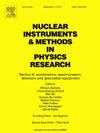Research on online monitoring methods for plutonium concentrations
IF 1.5
3区 物理与天体物理
Q3 INSTRUMENTS & INSTRUMENTATION
Nuclear Instruments & Methods in Physics Research Section A-accelerators Spectrometers Detectors and Associated Equipment
Pub Date : 2025-03-24
DOI:10.1016/j.nima.2025.170459
引用次数: 0
Abstract
In recent years, with the increasing global demand for clean, low-carbon, and reliable energy, nuclear energy has gained more attention and investment as a crucial component. As nuclear power plants are being constructed and operated on a large scale, the amount of nuclear waste discharged from reactors is also increasing. Currently, the PUREX reprocessing method is commonly used for recycling nuclear waste, which requires real-time measurement of nuclide concentrations in the solution to calculate the amount of material to be added. The traditional method involves staff sampling and laboratory analysis. Although this method is highly accurate, the detection results are delayed, and there is a certain radiation risk. Therefore, designing an efficient online monitoring system for spent fuel solution concentration is important for the recycling of spent fuel. While the online monitoring technology for uranium solutions is relatively mature, research on online monitoring of plutonium solutions is scarce. Against this backdrop, this paper simulates and designs an online monitoring system for plutonium concentration. Using the Geant4 simulation software, a model is designed with a silicon drift detector to explore the relationship between different concentrations of plutonium solution and its spontaneous X-ray intensity. A method for measuring plutonium concentration using spontaneous X-ray emission is proposed and validated. The paper also provides reasonable suggestions regarding the sample tube and detector parameters. Based on research into plutonium's spontaneous alpha decay, a combination of an X-ray machine and uranyl nitrate solution is proposed as an equivalent substitute model for corresponding concentrations of plutonium solution. The appropriate energy, angle, and time parameters for this model are determined through simulation, and its accuracy is experimentally verified to meet market demands, offering a new feasible solution for the calibration of plutonium concentration monitoring instruments. This provides valuable reference for the process design and management of spent fuel reprocessing.
钚浓度在线监测方法研究
近年来,随着全球对清洁、低碳、可靠能源需求的不断增加,核能作为能源的重要组成部分,受到越来越多的关注和投资。随着核电站的大规模建设和运营,从反应堆中排放的核废料也在不断增加。目前,核废料回收通常采用PUREX后处理方法,该方法需要实时测量溶液中的核素浓度,以计算需要添加的物质的量。传统的方法包括工作人员抽样和实验室分析。该方法虽然精度高,但检测结果滞后,且存在一定的辐射风险。因此,设计一套高效的乏燃料溶液浓度在线监测系统对乏燃料的回收利用具有重要意义。铀溶液在线监测技术相对成熟,而钚溶液在线监测研究较少。在此背景下,本文对钚浓度在线监测系统进行了仿真设计。利用Geant4仿真软件,设计了带有硅漂移探测器的模型,探讨了不同浓度的钚溶液与其自发x射线强度之间的关系。提出并验证了一种利用自发x射线辐射测量钚浓度的方法。并对样管和检测器的参数提出了合理的建议。在对钚自发α衰变进行研究的基础上,提出了x射线机与硝酸铀酰溶液的组合作为相应浓度钚溶液的等效替代模型。通过仿真确定了该模型合适的能量、角度和时间参数,并通过实验验证了其精度,满足市场需求,为钚浓度监测仪器的校准提供了一种新的可行方案。这为乏燃料后处理的工艺设计和管理提供了有价值的参考。
本文章由计算机程序翻译,如有差异,请以英文原文为准。
求助全文
约1分钟内获得全文
求助全文
来源期刊
CiteScore
3.20
自引率
21.40%
发文量
787
审稿时长
1 months
期刊介绍:
Section A of Nuclear Instruments and Methods in Physics Research publishes papers on design, manufacturing and performance of scientific instruments with an emphasis on large scale facilities. This includes the development of particle accelerators, ion sources, beam transport systems and target arrangements as well as the use of secondary phenomena such as synchrotron radiation and free electron lasers. It also includes all types of instrumentation for the detection and spectrometry of radiations from high energy processes and nuclear decays, as well as instrumentation for experiments at nuclear reactors. Specialized electronics for nuclear and other types of spectrometry as well as computerization of measurements and control systems in this area also find their place in the A section.
Theoretical as well as experimental papers are accepted.

 求助内容:
求助内容: 应助结果提醒方式:
应助结果提醒方式:


